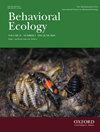Scope and adaptive value of modulating aggression over breeding stages in a competitive female bird
IF 2.2
3区 环境科学与生态学
Q2 BEHAVIORAL SCIENCES
引用次数: 0
Abstract
In seasonally breeding animals, costs and benefits of territorial aggression should vary over time; however, little work thus far has directly examined the scope and adaptive value of individual-level plasticity in aggression across breeding stages. We explore these issues using the tree swallow (Tachycineta bicolor), a single-brooded bird species in which females compete for limited nesting sites. We measured aggressiveness in nearly 100 females within three different stages: (1) shortly after territory-establishment, (2) during incubation, and (3) while caring for young chicks. Based on the timing, direction, and magnitude of behavioral changes between stages, we used k-means clustering to categorize each female’s behavior into a ‘plasticity type’. We then tested whether plasticity type and stage-specific aggression varied with key performance metrics. About 40% of females decreased aggressiveness across consecutive breeding stages to some degree, consistent with population-level patterns. 33% of females exhibited comparatively little plasticity, with moderate to low levels of aggression in all stages. Finally, 27% of females displayed steep decreases and then increases in aggression between stages; females exhibiting this pattern had significantly lower body mass while parenting, they tended to hatch fewer eggs, and they had the lowest observed overwinter survival rates. Other patterns of among-stage changes in aggressiveness were not associated with performance. These results reveal substantial among-individual variation in behavioral plasticity, which may reflect diverse solutions to trade-offs between current reproduction and future survival.竞争性雌鸟在繁殖阶段调节攻击性的范围和适应价值
在季节性繁殖的动物中,领地攻击的成本和收益应该随着时间的推移而变化;然而,迄今为止,很少有研究直接考察了不同繁殖阶段攻击的个体水平可塑性的范围和适应价值。我们利用树燕(Tachycineta bicolor)探讨了这些问题,树燕是一种单编码鸟类,雌鸟会争夺有限的筑巢地点。我们测量了近 100 只雌鸟在三个不同阶段的攻击性:(1)领地建立后不久;(2)孵化期间;(3)照顾幼雏期间。根据不同阶段行为变化的时间、方向和程度,我们使用k-均值聚类方法将每只雌蛙的行为划分为 "可塑性类型"。然后,我们测试了可塑性类型和特定阶段的攻击性是否随关键性能指标的变化而变化。大约40%的雌性在不同繁殖阶段的攻击性都有一定程度的下降,这与种群水平的模式一致。33%的雌性表现出相对较小的可塑性,在所有阶段都具有中等至较低的攻击性。最后,27%的雌性在不同阶段的攻击性急剧下降,然后又急剧上升;表现出这种模式的雌性在育儿期间的体重明显较低,孵化出的卵也往往较少,观察到的越冬存活率也最低。阶段间攻击性的其他变化模式与表现无关。这些结果揭示了行为可塑性在个体间的巨大差异,这可能反映了在当前繁殖和未来生存之间权衡的不同解决方案。
本文章由计算机程序翻译,如有差异,请以英文原文为准。
求助全文
约1分钟内获得全文
求助全文
来源期刊

Behavioral Ecology
环境科学-动物学
CiteScore
5.20
自引率
8.30%
发文量
93
审稿时长
3.0 months
期刊介绍:
Studies on the whole range of behaving organisms, including plants, invertebrates, vertebrates, and humans, are included.
Behavioral Ecology construes the field in its broadest sense to include 1) the use of ecological and evolutionary processes to explain the occurrence and adaptive significance of behavior patterns; 2) the use of behavioral processes to predict ecological patterns, and 3) empirical, comparative analyses relating behavior to the environment in which it occurs.
 求助内容:
求助内容: 应助结果提醒方式:
应助结果提醒方式:


